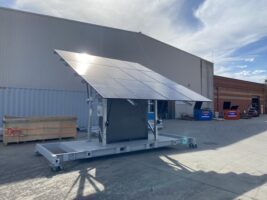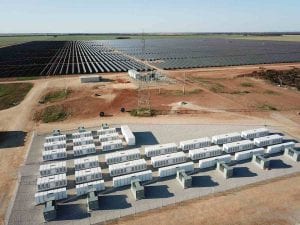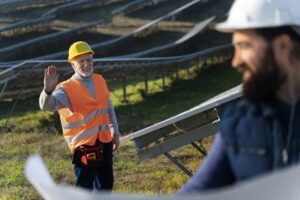Over the last few weeks attention if being focused on what happens to Australia’s economy as it emerges from Covid-19, where are the good ideas, the job opportunities and the short, medium and long term dividends.
The more experts look, the more they see that investment in renewable energy makes sense, and it helps address the other great environmental and health issue of the time – climate change.
At the week’s Stimulus Summit, co-hosted by the Smart Energy Council and RenewEconomy, several dozen experts – from the Queensland premier, through to four state energy ministers, economists, researches, energy experts, bankers, developers, farmers, business lobby groups and environmental advocates – came together to discuss some of their proposals.
From there, we’ve chosen these 10 mega projects and ideas that could be the focus of a government support and investment. Australia can do more than just build new roads, it can lay a pathway to the future.
This list does not include every great idea, or even some other big projects already proposed, but focuses on those discussed and reference at the conference. For that reason, Snowy 2.0 is not included as it appears to be a given, notwithstanding the growing concerns over its environmental and economic viability.
Transform energy-draining aluminium smelters into grid-balancing dynamos
Keeping the aluminium industry alive and competitve is one of the key challenges facing Australia. As David Leitch wrote here just last week, “even a cursory examination of China suggests that if smelting aluminium in Australia is to have a future, it needs to be more vertically integrated into electricity.” Furthermore, he adds, “there is no real future for the industry in Australia to be had from doing deals that extend the lives of smelters and perhaps associated coal fuelled power stations by a few years.”
According to Simon Holmes à Court, a mentor at the Energy Transition Hub, this can be achieved for the aluminium smelting industry by embracing flexibilisation and working hand-in-hand with renewables. But of course this will require technology and leadership. The technology is in the works.
A NZ company called New Zealand company Energia Potior has found that by retrofitting aluminium pots with enhanced temperature regulation – an insulated, heat-exchanger jacket – whole potlines can operate indefinitely and much more flexibly within a range 25% below to 25% above their normal operating point. Most of this demand “swing” can occur instantly, providing a highly valuable service to the grid that acts as very low-cost virtual storage. Now we just need the leadership.

Star of the South offshore wind
This project proposes to build Australia’s first offshore wind farm – a 4,000MW affair – off the coast of Gippsland in Victoria. While keenly supported by the Victorian government, the wind farm is proposed for Commonwealth waters, and so at the mercy of a federal government less than enthusiastic about onshore wind and ambivalent – at best – about offshore.
Nonetheless, the Star of the South, backed by Copenhagen Infrastructure Partners, continues to make slow progress. First publicly proposed in 2017, it has recently received approval to commence technical and environmental studies at the wind farm’s site, and in January began in process of seeking environmental approvals.
The project will have an estimated cost of around $10 billion once completed and is expected to create as many as 2,000 jobs during the construction phase. It will also require onshore transmission infrastructure and under-sea cable to link the project with existing grid connection infrastructure in the Latrobe Valley. Once built, it would have the capacity to power hundreds of thousands of Victorian homes.
Rooftop solar on low-income and public housing
Australia’s world-leading uptake of rooftop solar has always had one key downside, and that is equity. A number of companies have sprung up around the country to deal with the issue of imbalance in the distributed PV market; where those without their own homes, or suitable roofs, or enough money, or any of the above, miss out on cheap solar power.
One of these companies is Melbourne-based Allume Energy, which has specialised in using its clever SolShare solution to enable apartment blocks, big and small, to go solar. Late last year, the company installed its first shared system under the Victoria government-backed Community Energy Hubs program, giving a 52 apartment complex in the Melbourne suburb of Preston access to solar and storage.
Allume sees a huge opportunity for improvement in Australia’s low-income housing space, with state and territory government as well as not-for-profits providing homes for roughly 800,000 people around the country. Putting solar on all of these dwellings – detached, semi-detached and multi-unit – would not only level the playing field for people already at a disadvantage to home owners, but would add another 1,600MW to Australia’s rooftop solar capacity.
And it would be a great thing to do now, according to Allume, to offer some immediate economic relief to those most in need of it as Australia emerges from the post-coved crisis. On top of that, it has the advantage of being ready to deploy immediately, creating around 5,000 jobs, and helping to drive down national emissions.
Power up Australia’s farming industry with renewables
At One Step Off The Grid, we often see examples of farmers and rural communities that are leading the way in implementing renewables. For Wednesday’s Stimulus Summit, Farmers for Climate Action CEO Wendy Cohen shared some of her favourite examples of how farmers are embracing the shift to renewables, not just because it makes economic sense, but because it protects their greatest asset: the natural environment.
Keith Tulloch Wine is one example. It is the first certified carbon neutral winery in the Hunter Valley – the second in Australia – meaning that their business and wines create zero net emissions from grape to glass. To get to this point, the business has installed 65kW solar array, implemented energy efficiencies down the production line, and made changes to on-farm practices such as growing winter cover crops in the vineyard midrows that fix nitrogen and carbon in the soil. In Naromine, NSW, Karin Stark and her husband Jon Elder have installed Australia’s largest hybrid solar-diesel irrigation system on their farm. The 1500 solar panels have helped lower costs, reduce diesel use, and enhance environmental outcomes on-farm.
The One Million Jobs Plan
CEO of Beyond Zero Emissions, Eytan Lenko told the Stimulus Summit that BZE is working on the development of a ‘One Million Jobs Plan’, that would transform the Australian economy to a modern, high-skill and low-emissions powerhouse. Lenko said that Australia has all of the right skills, abilities, and resources to become a leading renewable energy superpower in the 21st century, it just required the political will to make the vision a reality.
The plan is an expansion of a similar vision BZE outlined for the Northern Territory, that proposed the construction of 10 gigawatts of renewable energy projects to revitalise the NT economy. Detailed in a report published last year, the ambitious plan would support the creation of more than 8,000 jobs in the NT and generate more than $2 billion in revenues for the Australian economy each year.
BZE has pitched the renewables vision as an alternative to the current priority of the NT government of expanding its gas fracking industry, an expansion that is now on hold due to a crash in gas prices and the economic uncertainty caused by Covid-19. BZE has outlined a vision that would include a significant expansion of Australia’s renewable hydrogen production, as well as the growth of an emerging renewable energy export industry, while also using the NT’s ample solar resources to convert major manufacturing and resource extraction facilities to running on 100 per cent renewables.
Asian Renewable Energy Hub
As reported by RenewEconomy on Tuesday, the massive 9 gigawatt proposal for the Asian Renewable Energy Hub in Western Australia was recommended for approval by the state’s Environmental Protection Agency.
Much like the BZE 10 gigawatt plan for the Northern Territory, the Asian Renewable Energy Hub proposes a massive build of wind and solar projects in Northern Australia, with power being exported into Asia via undersea transmission links. The Asian Renewable Energy Hub could deliver as much as $30 billion in new investment into the Australian clean energy sector.
Copperstring 2.0 from Townsville to Mt Isa
One main focus of the state energy ministers has been transmission links, including new and upgraded links between all mainland states, and Tasmania (see battery of the nation below). One idea that has been kicking around for nearly a decade has been the Copperstring project, now known as Copperstring 2.0, which proposes to link Townsville and Mt Isa, and provide opportunities for a heap of renewable energy projects, and mining resources in between.
Renewable Energy Zones
Battery of the Nation
Then of course there is the Battery of the Nation project, driven by state-owned utility Hydro Tasmania, proposes to draw on more than 2,500MW of pumped hydro opportunities identified across the island state to act as energy storage for the mainland National Electricity Market.
To facilitate this, and accommodate the addition of major new wind farms to Tasmania’s grid, the project would also require construction of an additional interconnector between Tasmania and Victoria – dubbed the Marinus Link.
HydroTasmania argues that the combination of the pumped hydro and the new transmission link could facilitate a rapid expansion of a crucial renewable energy generation – Victoria, alone, has a 50 per cent by 2030 target for renewable energy – providing an additional source of power and avoid such load shedding events that have in the past blighted Victoria over its summer months as the state’s ageing coal plants buckle in the heat.
“Victoria will need to access significant energy storage to ensure they can meet their renewable energy targets while keeping the power system reliable,” Hydro Tasmania CEO Steve Davy has said. “Tasmania has idle capacity waiting to be unlocked by market signals and delivered through the additional interconnection required by Battery of the Nation.”
Australia must shift its industries to renewables or lose our competitive advantage – Ross Garnaut.
Eminent Australian economist Ross Garnaut told the Stimulus Summit that Australia risked losing its competitive advantage if it did not invest in shifting the production of steel and aluminium products to processes powered by renewables.
Garnaut said that Australia’s heavy reliance on coal for industrial processing represented a significant risk in a global economy heading towards decarbonisation, but at the same time, Australia was ideally placed to take advantage of a shift to green manufacturing due to having ample supplies of cheap wind and solar resources. He suggests that by growing Australian based steel manufacturing using renewable energy, there was an opportunity to both revive Australian manufacturing, while also value-adding renewable energy by using it to process export goods.
“Australia is by far the world’s main source of many of the mineral minerals that require huge amounts of energy in their processing into metals,” Garnaut told the Stimulus Summit. In the zero-emissions world economy, we’re rapidly losing whatever advantages we have in the high-cost thermal energy economy.
“Combine low-cost Australian iron oxide with low cost Australian renewable energy, and you have globally competitive iron metal. That’s an advantage for Australia in processing metals that doesn’t exist in the coal-based steel industry. The advantages in low-cost energy will convert into competitiveness in energy-intensive industry.”
RenewEconomy and its sister sites One Step Off The Grid and The Driven will continue to publish throughout the Covid-19 crisis, posting good news about technology and project development, and holding government, regulators and business to account. But as the conference market evaporates, and some advertisers pull in their budgets, readers can help by making a voluntary donation here to help ensure we can continue to offer the service free of charge and to as wide an audience as possible. Thank you for your support.












